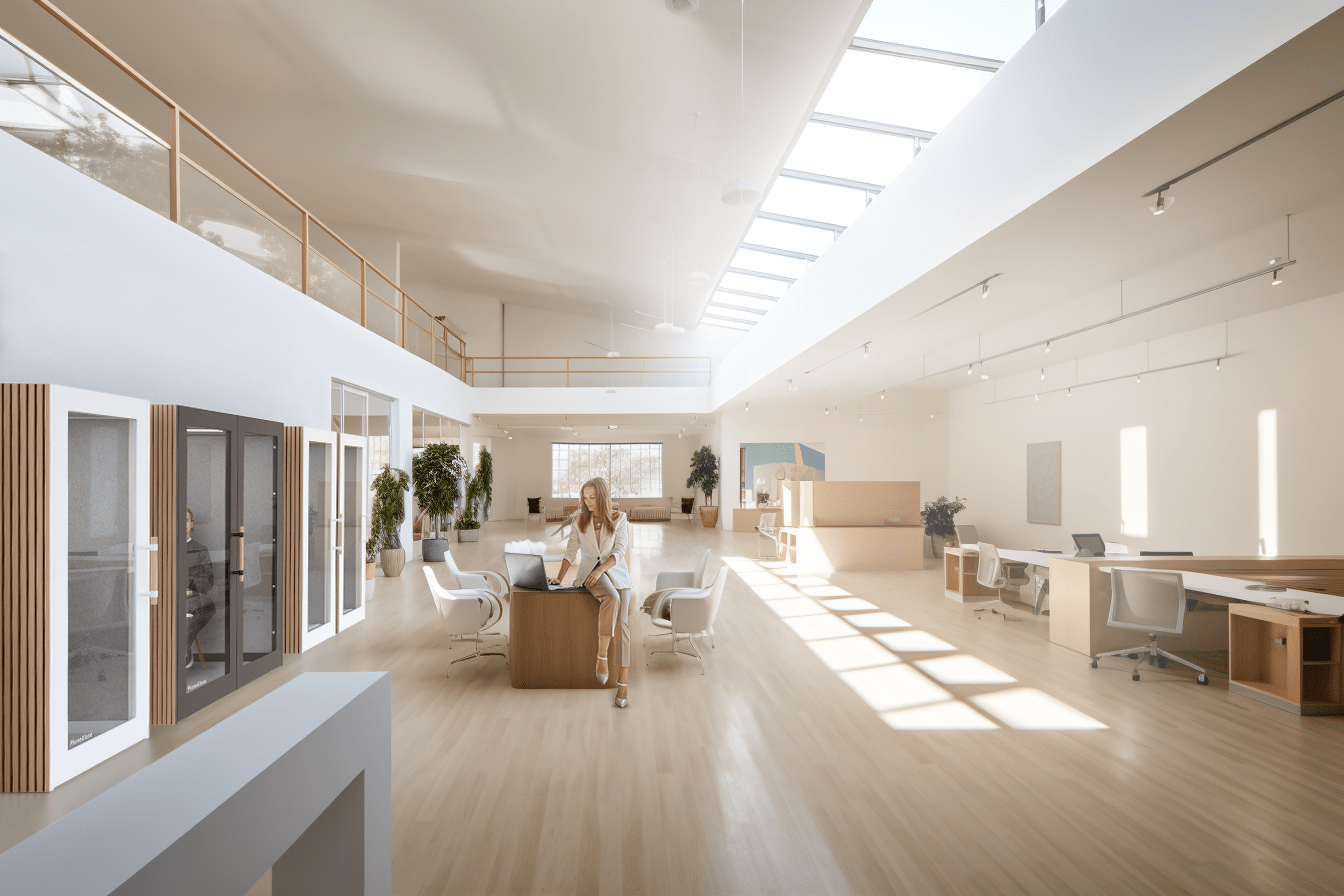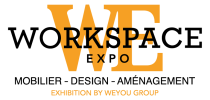Heading into 2024, it’s clear that office design is continuing to change in exciting ways. Modern offices are moving beyond mere functionality, incorporating aesthetics and features that nurture creativity, promote well-being, and foster collaboration. This approach is all about making offices that people enjoy working in and feel good about.
In short, modern office design is all about creating spaces that are versatile, comfortable, and suited to all kinds of work styles. Let’s take a closer look at some of the big trends in office design for 2024.
- Focus Spaces and Hybrid Offices
The post-pandemic era has reshaped how we perceive and design office spaces. Organizations now recognize the importance of flexibility, leading to the widespread adoption of the hybrid model – a seamless blend of remote and in-office work. This shift is evident in office designs, where you can expect more hot-desking solutions, dedicated video conferencing rooms, quiet focus areas, and touchdown spaces for transient employees. The future of hybrid office design, balancing private workspaces for undisturbed work and shared areas for collaboration, will increasingly include focus spaces such as soundproof work pods. A mix of sound-insulated phone booths for quick calls, as well as larger focus and meeting pods for extended periods of individual work, are predicted to become an essential necessity, rather than just an attractive option, and will become a standard element in modern office setups in the future.
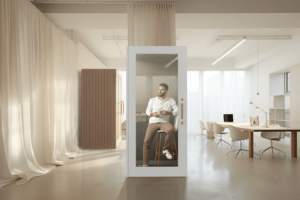
- Sustainable Designs
Sustainability is taking center stage in office design. The focus on energy-efficient designs, waste reduction, and sustainable materials is not only reducing carbon footprints but often leading to long-term cost savings. Eco-friendly design is a growing trend, promoting a thoughtful work community and a healthier workspace.
Sustainable solutions including energy-saving LED lighting, motion sensors, the use of recycled materials, durable and timeless designs, and modular and adaptable furniture are progressively being recognized as a requirement.
- Multi-functional Spaces and Adaptive Office Layouts
The walls are coming down, both literally and figuratively. Open floor plans continue to gain popularity but with a twist. Spaces are becoming multi-functional, serving as casual meeting areas, brainstorming pods, and relaxation zones. Moveable partitions, modular furniture, and adaptable layouts are the name of the game. These areas are designed to be inclusive and cater to different employee needs.
- Tech-integrated Offices
2024 will see further integration of technology into the physical workspace. Augmented Reality (AR) and Virtual Reality (VR) zones, smart lighting and temperature controls, and even IoT-enabled office equipment will become more mainstream.
Modern offices are incorporating advanced technology, such as AI for efficient energy use, climate control, and smart furniture. AI chatbots and sensors are also being used to enhance the work experience and improve the efficiency of office appliance usage.
- Health and Wellness-Centered Workspaces
Gone are the days when a simple breakroom sufficed. Modern offices are expected to incorporate gym areas, meditation rooms, and even small wellness clinics. Employees’ health (both physical and mental) is rightly recognized as crucial for productivity and retention.
These ideas are helping offices create an environment that encourages employees to look after themselves, feel connected with their colleagues, and ultimately enjoy their time at work.
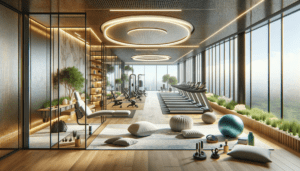
- Nature Infusion
In an age where well-being and mental health are at the forefront, nature-centric designs are gaining momentum. Biophilic design principles, which integrate natural lighting, plant installations, and nature-evoking materials, are becoming a staple in office spaces. This approach not only elevates the aesthetic appeal of the workplace but also significantly boosts employee productivity and enhances mood. In Denmark, raw wood materials are particularly favored in these biophilic designs, harmonizing beautifully with natural elements to create serene and inviting work environments.

- Color Psychology
The influence of color on productivity and mood has long been recognized. In 2024, we’re seeing a trend where color palettes are carefully chosen to evoke specific emotions, spark creativity, or create a sense of calm. From warm, earthy neutrals to soft pastels and rich jewel tones, colors in workspaces are selected to create the desired mood, like coziness or focus.
For instance, shades of blue, known to boost productivity, and enhance concentration and mental clarity, are ideal for general workspaces. Meanwhile, purple is chosen for brainstorming areas, encouraging creativity and new ideas. This strategic use of color, informed by behavioral science and color psychology, is increasingly important in office design. It’s about creating an environment that not only looks good but feels right, catering to the specific needs and well-being of those using the space.


- Acoustic Comfort
With open floor plans comes the challenge of noise management. Acoustic panels, soundproof zones, and noise-cancellation technologies will play a significant role in making workspaces more comfortable and less distracting. To combat the noise pollution of open-plan offices, companies are creating quiet zones and investing in soundproofing materials and pods, allowing for deep work and concentration.
- Reduced Desk Space and Enhanced Mobility
A significant shift in office design is the reduction of individual desk space, favoring a desk-to-employee ratio of about 50% or lower. This change caters to the dynamic nature of modern work, encouraging mobility and flexibility. The idea is to have a variety of spaces for whatever the day brings. Additionally, features like private sound-insulated booths are included for focused calls and video conferences, ensuring privacy in open office layouts. It’s a small change that makes a big difference in how people can focus and have privacy when they need it.
- Future-Proofing the Office
The work environment is continually evolving to attract and inspire people to do great work so that businesses can grow and flourish. One of the biggest workspace concerns of companies recently has been the risk of spending precious capital on office changes that might soon be out of date – either because employees won’t come back to the office full-time, or because their requirements change quickly. A smart solution is to design adaptable spaces using modular furniture that can be easily reconfigured. It’s also essential to have the flexibility in your office to modify or switch out different areas as demands shift. In 2024, it’s more crucial than ever to create an office design that’s ready for the future and can evolve with your business.
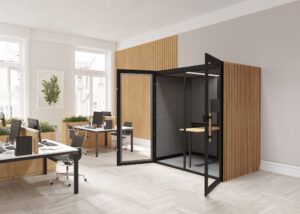
The year 2024 is set to be an exciting era for office design. With a blend of technology, sustainability, and well-being, workplaces will be more than just places to work – they’ll be spaces that inspire, rejuvenate, and bring teams together. These trends reflect a shift towards creating office environments that are adaptable, comfortable, and conducive to both individual and collaborative work, while also being mindful of environmental sustainability and technological integration.
Key Considerations When Planning an Office Layout
- Understand Your Employees’ Need
Every team member has unique requirements based on their role, tasks, and personal circumstances. Flexibility in workspace design is crucial to cater to these varied needs. Employees should be able to work where they feel most productive.
- Maximize Space Efficiency
Efficient use of space is essential in office layout planning. Think about how best to arrange your furniture and equipment to maximize available space. Innovative design solutions, such as multi-use, focus, and break-out zones, can help maximize the utility of available space.
- Budget Considerations
When planning upgrades or remodeling your office, keeping an eye on the budget is always a factor. It makes sense to spend time researching the market for good-quality furniture that will last a long time. This approach can save you money down the road because you won’t have to replace cheap, easily broken items frequently.
Moreover, it’s key to discern between spending on functionality versus splurging on unnecessary design elements. If you’re working with a limited budget, go for classic furniture designs. They fit well in most office spaces and are usually made to last. This way, you get the most out of your money by investing in pieces that won’t need replacing any time soon.
See PhoneAlone’s solutions here.
Sources:
Gensler’s Design Forecast 2024
Fast Company: The office is about to enter its experimental phase
House and Garden: A colour consultant on the colours to know for 2024

